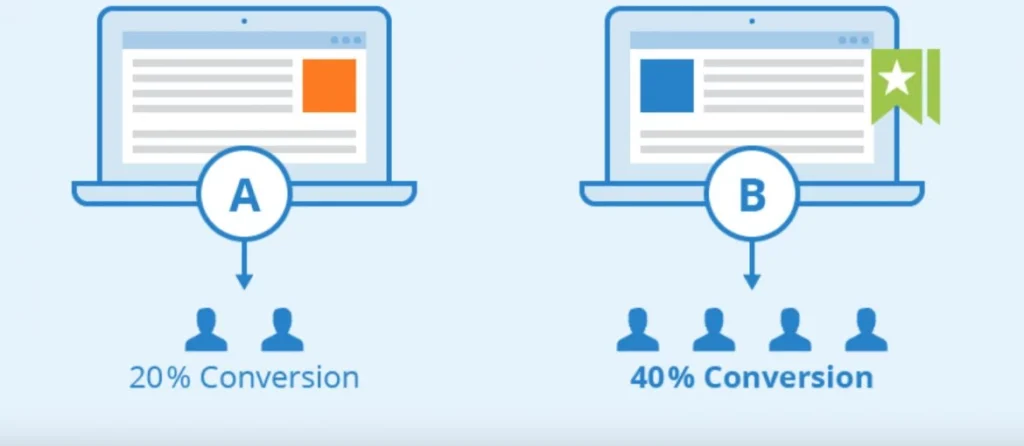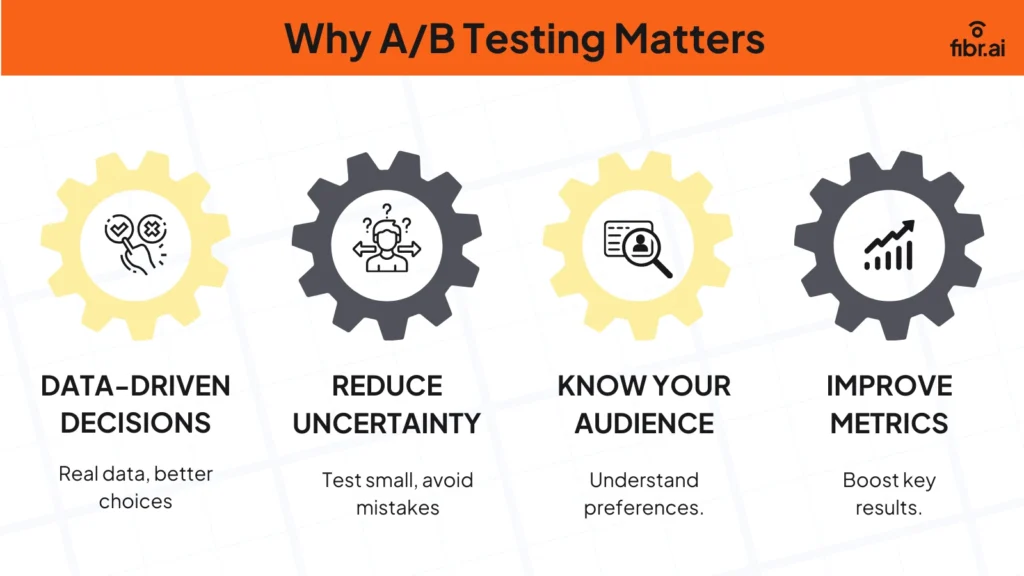
A/B testing can be basicically defined as a process to test out two options in a situation to see which scores better. The two options can be 2 marketing strategies, 2 learning methodologies, 2 store layouts, 2 website designs, 2 customer care approaches, 2 shopping options, 2 farming methods,
While the prime use of A/B Testing is within the marketing industry to convert leads into sales, it does not stop anyone to use this scientific method to make better decision in daily life too.
In today’s data-driven world, businesses are constantly seeking methods to improve their products, services, and marketing campaigns. One powerful tool that can be used to achieve this goal is A/B testing. A/B testing is a statistical methodology that enables businesses to compare two variations of a product or service to determine which one performs better for a specific audience. By systematically measuring and analyzing the results of these comparisons, businesses can gain valuable insights that can be used to optimize their offerings and achieve their marketing objectives.

What is A/B Testing?
A/B testing, also known as split testing, is a controlled experiment that involves presenting two different versions of a product or service to a statistically representative sample of users. These two versions, known as the control and the variation, are typically identical except for one specific element that is being tested. This element could be anything from the design of a website landing page to the wording of a marketing call to action.
Once the A/B test is launched, the performance of both versions is carefully monitored. Key metrics, such as conversion rates, click-through rates, and user engagement, are tracked and analyzed to determine which version is more effective in achieving the desired outcome. The outcome of the test will then guide the business in deciding whether to adopt the variation as the new standard or to continue using the control version.
But why compare just 2 options when we can compare maybe 5 at a time? Because its not optimal. The optimal results come out when the number of variables in an environment are less. Therefore its best to use A/B testing when you are:
Testing only one variable.
Testing two extrmely different versions of something.
Needing data and insight quickly.
Taking multi-scenario approach (e.g. testing 2 fertilizer’s across different seasons)
Working with large data (e.g. number of customers walking into a mall)

Benefits of A/B Testing
A/B testing offers a multitude of benefits for businesses of all sizes and across all industries. Here are some of the key advantages of incorporating A/B testing into your decision-making process:
Data-Driven Decisions: A/B testing removes the guesswork from decision-making by providing businesses with concrete data to support their choices. By objectively measuring the performance of different variations, businesses can avoid relying on intuition or anecdotal evidence, which can often be misleading.
Improved User Experience: A/B testing can be used to optimize the user experience for your target audience. By testing different website layouts, call to action buttons, and other design elements, you can identify the variations that resonate most strongly with your users and lead to a more positive and engaging user experience.
Increased Conversion Rates: A/B testing is a powerful tool for boosting conversion rates. By testing different marketing messages, landing page designs, and pricing strategies, you can identify the variations that are most effective in converting website visitors into paying customers.
Reduced Risk: A/B testing allows businesses to test new ideas and features in a controlled environment before rolling them out to their entire user base. This can help to mitigate the risk of implementing changes that may have a negative impact on user engagement or conversion rates.
Continuous Improvement: A/B testing is an iterative process that can be used to continuously improve your products, services, and marketing campaigns. By regularly conducting A/B tests, you can gain valuable insights into what resonates with your target audience and use this knowledge to make ongoing improvements.
Common Applications of A/B Testing
A/B testing can be applied to a wide range of marketing and product development initiatives. Here are some of the most common applications of A/B testing:
Website Optimization: A/B testing is a popular tool for optimizing website design and functionality. Businesses can use A/B testing to compare different website layouts, headlines, call to action buttons, and product descriptions to determine which variations generate the most leads or sales.
Marketing Campaign Optimization: A/B testing can be used to optimize marketing campaigns across various channels, such as email marketing, pay-per-click advertising, and social media marketing. By testing different subject lines, email copy, ad creatives, and social media posts, businesses can identify the variations that resonate most effectively with their target audience and drive higher engagement rates.
Pricing Strategy: A/B testing can be a valuable tool for determining the optimal pricing strategy for your products or services. By testing different price points, businesses can gain insights into how price changes affect customer demand and revenue generation.
Product Feature Development: A/B testing can be used to evaluate the effectiveness of new product features before they are rolled out to the entire user base. By testing different variations of a new feature, businesses can gather feedback from users and determine whether the feature is likely to be adopted and used.
Examples of A/B Testing in Action
Here are a few real-world examples of how businesses have successfully used A/B testing to achieve their marketing and product development goals:
Headline Optimization: An e-commerce company wanted to increase click-through rates on their product page. They conducted an A/B test where they compared two versions of the product page headline. Version A used a generic headline that described the product category. Version B used a more specific headline that highlighted a key benefit of the product. The A/B test revealed that Version B, with the benefit-focused headline, resulted in a significant increase in click-through rates, demonstrating the power of clear and compelling messaging.
Email Subject Line Testing: A B2B marketing agency wanted to improve the open rates of their email marketing campaigns. They conducted an A/B test where they compared two different email subject lines. Subject Line A used a question format to pique the recipient’s curiosity. Subject Line B directly stated the value proposition of the email content. The A/B test results showed that Subject Line B, with the clear value proposition, led to a higher email open rate, indicating that recipients are more likely to open emails that communicate the benefit upfront.
App Feature Testing: A social media app developer wanted to test the user adoption of a new in-app feature. They conducted an A/B test where they randomly divided their user base into two groups. Group A received the app with the new feature enabled by default. Group B received the app with the new feature disabled by default, requiring users to opt-in to activate it. The A/B test results showed that a higher percentage of users in Group A explored and used the new feature, suggesting that pre-enabling new features can encourage user adoption.
Getting Started with A/B Testing
If you’re interested in incorporating A/B testing into your marketing and product development strategies, here are some initial steps to consider:
Identify Your Goals: The first step is to clearly define your goals for the A/B test. What specific metrics are you hoping to improve? Are you aiming to increase website traffic, boost conversion rates, or enhance user engagement? Having a clear understanding of your objectives will guide you in selecting the elements to test and the metrics to track.
Choose Your Variables: Once you’ve established your goals, you need to determine which element you want to test. This could be anything from a website layout element to a specific piece of marketing copy. It’s important to choose a variable that is measurable and has the potential to significantly impact your desired outcome.
Develop Your Variations: Create different variations of the element you’ve chosen to test. Make sure the variations are distinct enough to generate a measurable difference but are still relevant to your target audience.
Set Up Your Test: There are a variety of A/B testing tools and platforms available online. Select a tool that meets your needs and allows you to easily segment your audience and deliver the different test variations.
Run the Test: Once your A/B test is set up, launch the test and allow it to run for a statistically significant period. The duration of your test will depend on the volume of traffic you receive and the complexity of the element you’re testing.
Analyze the Results: After the test has run its course, carefully analyze the results to determine which variation performed best in achieving your goals. Look for statistically significant differences in the key metrics you’ve been tracking.
Take Action: Based on the results of your A/B test, make an informed decision about which variation to implement as the standard. If the test was inconclusive, you may need to refine your test and run it again with different variations.
Successful examples of A/B testing that can be found online.
- Testing Product Page – Swiss Gear Company
- Banner test – Sony VAIO
- Pricing test – Codeacademy
- Search bar test – Matalan’s
- Changing color of “Get Started Now” button to increase sales – Performable
Conclusion
A/B testing is a powerful tool that can be used by businesses of all sizes to make data-driven decisions and achieve their marketing and product development goals. By systematically testing different variations and analyzing the results, businesses can gain valuable insights into how to optimize their offerings for their target audience. A/B testing is an ongoing process that can lead to continuous improvement and a competitive edge in today’s digital marketplace.